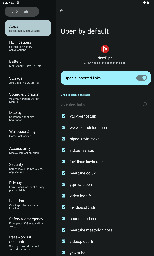PS3 is a pirate's dream!


I've set up a local mail archive with just dovecot + imap plugin. you don't need the full mail server with postfix and whatnot, as it's not intended to send anything anywhere, or even receive anything for that matter. it just sits there ready to be searched with thunderbird, no need for other complex solutions you've mentioned.







there are no good linux tablets, for any price; by "good" I mean it works as good as an Android or iOS tablet. everything is from not-as-good to way worse and there are things that are downright unusable.
whichever platform you choose (Gnome, Plasma or any of the derivatives like Phosh, Plasma Mobile, etc.) the experience beyond the first 15 minutes (hey, this actually works!) is pretty bad. it's certainly not usable as a main device that you depend on and use for actual work; as a dicking-around kinda project, sure, have at it.
before you spend that kind of money, my recommendation is to get an older Surface Pro or Dell Latitude 2-in-1 in the $150-200 range and see if that functionality is something you can live with. those can be had with up to 16 GB on-board and the SSDs are replaceable (Dells are more serviceable). kernel support is spotty, not all of the features work for all devices, mainly cameras and such; consult the linux-surface github.
edit: just saw this comment, my experiences are similar. the rest of the comments where people think what a device might work like you should disregard.
I mean, OK, it's a vulnerability and there are interesting implications, but this is hardly significant in any pracitcal sense of the word.
the potential victim has to run their system without a firewall, has to print to the printer they've never interacted with before and then the attacker can run shit with whatever the printing system's user id is, which shouldn't be an issue on any reasonably modern distro.
I routinely remove cups and friends from any system I run because I have no need for printing and it bothers me to see it constantly during every system upgrade.






feels like an austin powers discarded skit... achieving world dominance by pretending to be mike from accounting who does excel like really good



*affect.
thanks for the humorous takes, but what's the verdict...? and what's the next step, download posts and settings and move elsewhere?
you're overcomplicating it. get a separate $20 SSD and install the OS to it, dicking around with wine and tools within virtualbox is a headache you don't need. set it up as desired (I recommend using flatpak versions of lutris and friends because of freshness) and then install the games one by one, followed by transferring the game data/settings/etc. you can experiment to your heart's desire because you always have the fallback solution of your original drive.
then, when you know what's what and where's what you can make the transition. good luck!
if they run hardware that's not cutting edge, by all means, that's the best solution as a first distro.
ubuntu is important as a stepping stone. myself and everyone I know that's on Fedora et al started with Ubuntu. we learned what's what and how to go about doing things and after hitting the ceiling one too many times, we tried other stuff, found better havens and finally abandoned it forever.
so I'd caution against any action aimed at hurting it. leave it be and know that it's still the most user-friendly solution out there and the one that's most likely to "just work" for most people. it'll convert people over, whether from Windows or MacOS. once they've crossed over, they're more likely to wander further.
it's a lackluster experience which ever way you turn. plasma has a better touch experience and consistency but its keyboard (maliit was it?) is horrible. GNOME's keyboard is better but still crap.
everything feels like a proof-of-concept, something that was shipped in this sorta-works state and left. if you've ever used an android tablet, this is a long, long way off.
GNOME terrorized us for a decade with those comically gigantic UI elements because it's supposedly touch friendly but the moment you start touching them it feels like utter crap.
try running android x86 on it, I had some good experiences with bliss OS. old kernels there, so hardware support is hit n miss.
bazzite is fedora based? If so, your filesystem is btrfs and your /home is a subvolume, same as your / (root). you can install a new operating system in a btrfs subvolume (e.g. /blendosroot), then have systemd-boot or grub mount it as root and mount your existing home from it.
sadly, there's no noob-friendly way to achieve this, but if you're adventurous, you have enough search terms to make it happen.
I do without.
no way am I bothering with installing windows, in a VM or elsewhere.
sure, that's also viable. I just never had the console experience, so was inclined to share.
come to think of it, I tried it a few months back but it was pretty slow (tried RDR1 on a R5 5600/RX 570 with Fedora 40 KDE). supposedly it's way better now
absolutely. I have a list as long as my arm of irritants that are 99% just the absence of sane defaults. I'm not saying that's what's deterring people from switching over, but it's not helping either, is it?
every DE, distro, whatevs I install, I try to imagine what this looks like to a non-techie, how would a random grams deal with this... and it's not looking good.
apple has a vertically integrated tech stack and are free to focus their sinister efforts elsewhere; they don't have to dick around with 15 different DEs and 27 WMs, 50 teams pulling in 127 different directions, abandoned paths and duplicated efforts galore. just imagine where The Linux Desktop would be at if we had just one DE/WM and all devs would pull in the same direction...
I don't have the answer. it's chaos over here and out of that chaos eventually some order emerges. it's unquestionable that shit's way better than five years ago, let alone 10 or more... but it's so slow and wasteful and it pains me that I see no other option.
meanwhile this (hey, try this shit out) is the best we as users can do; I know I regarded KDE/Plasma for the longest time as something clunky and un-serious and whatnot - I couldn't have been more wrong. things that are outright deal-breakers (like the years-long refusal to implement scroll speed in Gnome) are handled beautifully over there, and then some.
This latest UKI work for Fedora will lead to better UEFI Secure Boot support, better supporting TPM measurements and confidential computing, and a more robust boot process.
and HOPEFULLY lead to a less jerky-flashy-switchy boot xperience, looks like a Vegas light show at present. switched to systemd-boot, but it's only a tiny bit better, still switches modes/blanks screen like five times.
the whole apple-bad thing aside, you're getting a non-expandable 8 GB laptop, of which a significant portion goes to graphics. that's pretty low today, and it's gonna be worse down the road. speaking of graphics, although Asahi has basic functionality, the driver isn't 100% yet.
I hope you don't plan on torrenting a buncha stuff, as the SSD is small and non-replaceable and after years of use has an insane TBW number.
the battery longevity is a solid argument but you are buying a 4 year old battery that will show signs of aging.
I am all for repurpose/reuse/recycle, but unless you get it for free, or close to it, this thing s a bad idea. get a similarly aged business-class laptop (thinkpad, yoga, latitude, elitebook, etc.) that you can cram full of RAM and storage and replace practically every component if it fails.
kinda like trillian in the olden days... not sure all them proprietary services are gonna let 'em use their platforms though.
do any of these forks support E2EE? I don't mean the OG "private chat" thingy that Telegram supports.
I mean like an add-on, the way pidgin had an OTR plugin that enabled private comms over Google's unencrypted XMPP servers.
as a consequence, that would also encrypt everything in the cloud and prevent your chat history being ingested for LLM training and whatnot.
I have a question: wtf is javascript doing in a modern desktop?
my laptop is comparatively old (t480s, 8th gen) but had the same issues with battery drain on F38. I've switched to debian and the situation is way better, overnight drain percentage-wise is in the single digits range. still nowhere close to my old macbook, but workable.
edit: no it isn't, tested F38 and D12 on separate partitions, both lose same amount; ~1 %/hr of standby (regardless of deep or s2idle setting), so 7-8% overnight.
edit 2: looking into making suspend-then-hibernate work, that should fix everything; sleep for 30 mins and hibernate afterwards.

thanks for the link, explains it very well. how bout my activity, like IP address, up/down votes, clicks on links, favorites and whatnot, is that federated around or how does that work, i.e. who has access to it?
I have no direct experience with any pen related issues but kudos for taking the time to open all them reports. sooner or later, someone is going to tackle those issues. let's hope it's soon.
there's a lot of things that need to be re-implemented in wayland and it currently sucks for a lot of people; but forcing change by pushing wayland onto the users is the only way forward, way too many people are comfortable with status quo.
any mods around? what's this bullshit have to do with programming?
that exists in the current version, it asks to press back twice to exit
QOwnNotes (had to look up the exact name as it's the stupidest app name ever). but compared to joplin it's lighter, faster, simpler (no database but individual .md files and folders) and works well enough with syncthing.
straight out of the "silicon valley" timeline, I can practically see Jian-Yang pitching it
the least you can do is provide the basics - AMD/Intel, GPU, wayland/x11, os and kernel version, I'm not looking up what an 8th gen x1 runs on.
as to your question, seen similar with ryzens freezing for seconds intermittently on older kernels.
I think the share functionallity is missing. It could be used for what you want. I'm used to sending a video I come accross to macast and I can't get that in Jerboa at present.
not important for this use case. I'm referring to the fact that I can close it shut and leave it for a week. I open it and it's ready to go and the battery has barely lost a percentage point. that's 2010 tech and something completely unattainable to me 13 years later. I've moved on from macOS but can't help being envious.
I don't think any Thinkpads have AMI firmware, which is the source of this fuckup.
does it matter how bad it is? does it matter how much shit is in a shit sandwich?
I'm not having it however little there is.
just watched a video where the dev explains LG; this is for a Windows VM that allows GPU pass-through, or am I missing something? when you say "host" and "client", you're referring to two physical devices or how does that work in your case?
I have two physical machines (both running linux, Fedora 40 on the desktop and Debian 12 on the laptop) connected to the same monitor, keyboard and mouse and I need to alternate between them.
edit: aha, the LG site refers to KVM as kernel-virtual-machine, whereas I'm talking about KVM as in keyboard-video-mouse; completely different things, maybe I should amend the post's title.
granted, but they are inextricably linked and you have to consider the software that does or doesn't allow you to utilise said hardware.
like, I've waited years for kernel devs to catch up to the proprietary hardware in my 2-in-1, namely the drivers for the ipu3 cameras. they are now obsolete and the focus is on ipu6 models. kinda important if you want this to be your main device.
and as to software, it's important to note that the touch-friendliness was an afterthought, so it isn't propagated through the system. like, in Gnome's own system settings app, you can't initiate dropdowns with touch! that's a pretty significant UI element that's been around since forever. another common stumbling block is initiating "right-clicks" on elements, by long-pressing stuff; sometimes it works, other times not. the on-screen keyboard usually appears when an input is focused, but it doesn't often enough that it's annoying.
speaking of, Gnome's OSK is only somewhat usable (and less so if you're on a non-US layout). if you're used to Android or iOS keyboards, it's pretty basic. however bad that is, Plasma's maalit keyboard makes Gnome's look like advanced alien tech, it's broken on so many levels you're better off disabling it. I didn't follow development in the past year or so, but one default "feature" of Gnome OSK was that it remembers everything you type - that includes passwords! - and helpfully offers them on the suggestion strip, with no way of turning it off!
obviously, the OSKs don't work if you need to unlock your disk on boot and I'm not sure they work on the login/lock screen; someone please correct me if I'm misremembering.
OK, screw OSKs, you're gonna use the cover keyboard. except, it's prone to just not work half the time. then you rip it apart (pardon, you disconnect it) and attach it again to have it working, maybe.
you're used to reading stuff, books, comics, whathaveyous, for hours. well, those screens aren't super power-efficient and the batteries aren't humongous either. plus, that thing is heavy and thick (easily twice my Samsung Tab) so maybe don't hold it up ABOVE YOUR FACE WHILE LYING DOWN - ask me how I know! speaking of screens, they aren't the greatest - try scroll-flinging a long page and watch this stuttering-flashing mess; you're gonna need new eyes if you keep this up.
I tried to make one work as a 3-in-1 solution. why have a desktop, a laptop, and tablet when I can have a single device and forego the constant copying and syncing and stuff. semi-decent specs, i5, 16 GB, 500 GB NVMe more than enough for my needs, so I got me a USB-C Dock, attached a huge 4K monitor, LAN, sound, mechanical keyboard, mouse... when I'm needed in the field, just detach it and off I go with all my shit on the drive AND I got a free iPad out of the deal, I just have to marvel at how smart I am!
yeah, nah. bottom line, they are bad as desktop replacement (throttled all over the place on account of anaemic cooling + whiny fan holler), bad as a laptop (on account of the kickstand, you hafta use it on a desk only, plus the keyboard is pretty bad and so is the tiny touchpad) and very bad as tablet (for reasons galore, some mentioned above).
so, like I said, as a fun project to play with - by all means, it's super fun trying out different OSs/apps (I haven't touched on Waydroid, Android x86, FydeOS, note-taking apps, etc.) but, as a daily driver, one that your livelihood and/or education depends on - hard pass.
wish they would say what the "old intel CPU" refers to and which ate the modern ones that don't need the hack.
I have no idea what this challenge is (I automatically assume it's some cringe when I read "challenge" also that pic is... what?), but you don't run Mint/Debian/Ubuntu if you have super-fresh hardware, like AMD 7000-series or Intel 14th gen and so on. in that case you have to go with Fedora or one of its derivatives (Nobara, Bazzite, etc.), because they have the newest kernels that allow this hardware to run OOB.
if you have a bit older hardware (like 2-3 years old), Mint or Debian is your best bet; Ubuntu if you have to, and only as a stepping stone. it's a solid base and if you use flatpak for everything (Firefox, Chrome, Lutris, Steam, etc.) you won't have issues with old packages and you'll get the best of both worlds - stability and supported hardware.
I've made it work on arch, debian and fedora, on a T420s, T480s, T14 AMD, MBPr 2012, each on luks2 + btrfs with systemd-boot, and it works flawlessly on all of them. the setup is super-involved and cumbersome though but it's easily accomplished once you get the hang of it.
the links posted here along with the arch wiki is what I used. it helps if it's not your primary and only device, so you have time to retry until you get it right.
because Telegram's UI/UX is second to none; possibly iMessage or whatever it's called is close, albeit with way limited functionality. Signal and friends look like a PoC from 2015 in comparison. also the apps, on mobile and on desktop, have a low memory footprint with no bloated electron crap, the cross-device sync is phenomenal and there's the virtually unlimited cloud storage. if an addon could piggyback off of that, that would be spectacular.
however, OP's insight as to this being against ToS is obviously a deal breaker. seeing as how they're adamant about leaving all your shit unencrypted in the cloud I'm looking for other havens, begrudgingly; I've been a user from the early days.
the way I understood it is CFW allows all models to play PS2 games. I tried God of War and some Tekken, forgot which, started up without issues. I also have some settings to upscale PS2 games, don't know if that's a CFW thing or if that's standard.
also, some fat models have real PS2 hardware in them, so no need for emulation.
thank you!
you need a swap file, a swap subvolume, or a swap partition that's RAM + 50%, on account of zram. then you need systemd scripts that disable zram and enable swap on suspend and do the reverse on resume. also, you need some selinux tuning to allow you to write to said file. you have a detailed howto in Fedora Magazine.
stop using bullshitgpt.
edit: here's the article.
that (and many other irritants) is why I switched to plasma. please try it before going back, it's way better in every regard.
why not
btrfs send | btrfs receive? is there some advantage to rsync?did you hotswap the drives after each
btrfs replaceor shutdown and then swap?what's your host OS and do the drives spin down if inactive?
thanks for the writeup!